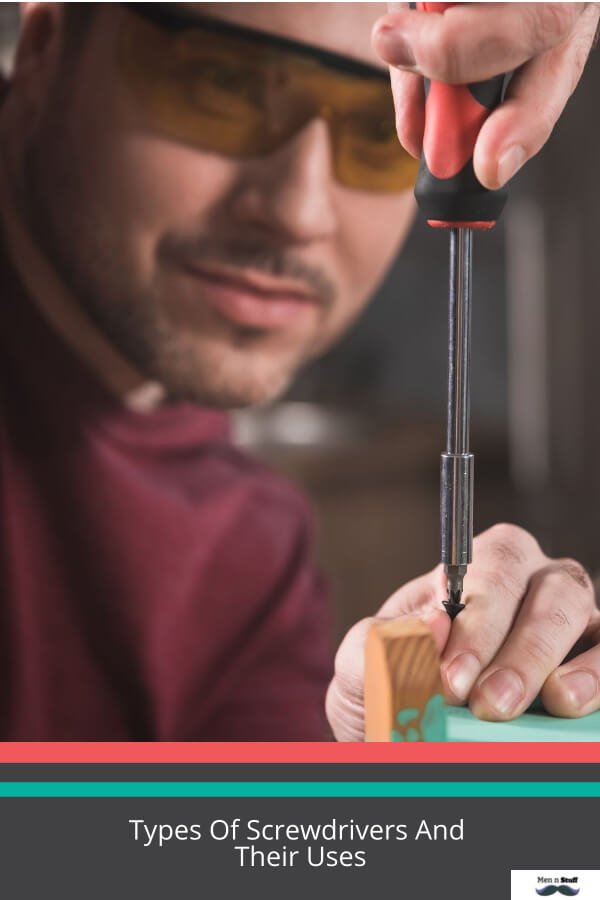There are over 20 types of screwdrivers, but the most common are:
- Flat: a thin, straight blade that fits into a single slot in the screw.
- Phillips: a cross-shaped blade that fits into a Phillips-head screw.
- Pozidriv: a modified Phillips blade with additional indentations for a more secure fit.
- Torx: a star-shaped blade that fits into a Torx screw.

What Are The Main Types Of Screwdrivers?
The spectrum of basic hand-held tools is incomplete without the mention of screwdrivers. Serving a variety of purposes across many industries, screwdrivers come in various shapes, sizes, and types. This article shall explore eight main types of screwdrivers that are largely utilized.
- Flathead ScrewdriverAlso termed as a slotted screwdriver, the Flathead is arguably the oldest and most common screwdriver type. It has a single, flat blade that fits into the slot of the screw.
- Phillips ScrewdriverThe Phillips screwdriver, originally invented by Henry F. Phillips, has a ‘X’ design that fits into the cross-shaped indentations of the screws. This shape provides more torque than the flathead screwdriver.
- Pozidriv ScrewdriverAt first glance, the Pozidriv could be mistaken for a Phillips screwdriver. However, the Pozidriv has an additional four contact points, leading to increased torque without the risk of cam-out.
- Torx ScrewdriverThe shape of Torx screwdriver’s tip is like a six-pointed star. It was designed to permit higher torque transmission than traditional screwdrivers without damaging the screw or the driver.
- Hex ScrewdriverThese are designed for use on screws with a hexagonal indentation. Hex screwdrivers provide a greater contact surface area with the screw, thus enabling high torque application.
- Robertson ScrewdriverConsidered as a reliable type of screwdriver, the Robertson or square-tip screwdriver has a square-shaped tip that fits snugly into screws with a square recess.
- Nut DriverNut drivers are essentially socket wrenches for screws. They have a socket attached to a shaft and handle, designed for use on nuts and bolts.
- Jeweler’s ScrewdriverThese screwdrivers are miniature versions of the slot and Phillips-head styles. They’re specifically designed for precision work like jewelry making, watch repair, or electronics.
Types of Screwdrivers in Brief
| Screwdriver Type | Description |
|---|---|
| Flathead Screwdriver | Features a single flat blade |
| Phillips Screwdriver | Characterized by a ‘X’ design |
| Pozidriv Screwdriver | More contact points than Phillips, reducing cam-out |
| Torx Screwdriver | Six-pointed star shape tip for higher torque transmission |
| Hex Screwdriver | Designed for screws with a hexagonal indentation |
| Robertson Screwdriver | Has a square-shaped tip |
| Nut Driver | Socket wrenches designed for screws |
| Jeweler’s Screwdriver | Miniature versions for precision work |
In conclusion, the type of screwdriver you will need depends on the task at hand, as different screwdrivers are designed to perform specific functions. Always ensure you use the correct type to prevent damage either to the tool or the screw.
Screwdriver Uses and Applications
Screwdrivers are versatile hand tools designed for turning or driving screws. They come in various types, each suited for specific uses and applications. Here’s a detailed breakdown of screwdriver types and their respective uses:
- Flathead Screwdriver (Slotted):
- Use: Flathead screwdrivers have a flat, blade-like tip that fits into slotted or flathead screws with a single groove.
- Applications: Commonly used for household tasks, such as assembling furniture, tightening electrical connections, and opening paint cans.
- Phillips Screwdriver:
- Use: Phillips screwdrivers have a cruciform-shaped tip with a cross-shaped recess, designed to fit Phillips screws.
- Applications: Widely used in construction, automotive, and electronics for tasks like fastening screws in appliances, electrical panels, and machinery.
- Torx Screwdriver:
- Use: Torx screwdrivers feature a star-shaped tip that matches the corresponding Torx screws (also known as star or six-lobe screws).
- Applications: Commonly found in electronics, automotive, and computer hardware for their resistance to cam-out (slipping) and enhanced torque.
- Hex Screwdriver (Allen Key):
- Use: Hex screwdrivers have a hexagonal-shaped tip, often referred to as an Allen key or wrench. They fit into hex screws or bolts.
- Applications: Used in furniture assembly, bicycle maintenance, automotive repairs, and machinery assembly that employs hex fasteners.
- Robertson Screwdriver (Square):
- Use: Robertson screwdrivers have a square-shaped tip that matches Robertson screws, featuring a square recess.
- Applications: Popular in Canada and certain industries for their improved torque transfer and reduced cam-out.
- Pozidriv Screwdriver:
- Use: Pozidriv screwdrivers have a tip similar to Phillips but with additional smaller cross ribs. They fit Pozidriv screws.
- Applications: Found in automotive and engineering applications where high torque and reduced slippage are critical.
- Tri-wing Screwdriver:
- Use: Tri-wing screwdrivers are designed for screws with three wing-like recesses, commonly found in electronics, such as gaming consoles and cellphones.
- Applications: Used for disassembling or repairing electronic devices that incorporate these specialized screws.
- Spanner (Security) Screwdriver:
- Use: Spanner or security screwdrivers feature two round pins or holes in the tip to fit into corresponding spanner screws, also known as snake eye screws.
- Applications: Typically used for tamper-resistant applications, such as securing access panels or equipment covers.
- Nut Driver:
- Use: Nut drivers resemble screwdrivers but have a hollow, cylindrical tip to fit over nuts or bolt heads.
- Applications: Used for tightening or loosening nuts in electrical and mechanical installations.
- Y-Shaped Screwdriver (Tri-point):
- Use: Y-shaped screwdrivers have a tip with three branches, designed for screws with triangular recesses, often found in electronics like laptops and game controllers.
- Applications: Essential for repairing and upgrading electronic devices with tri-point screws.
- Clutch Screwdriver:
- Use: Clutch screwdrivers have a tip with a circular recess designed to drive screws with a corresponding circular socket.
- Applications: Common in door hardware, cabinet assembly, and other applications requiring secure and flush fastening.
- Insulated Screwdriver:
- Use: Insulated screwdrivers have handles designed to protect against electrical shock. They are essential for electrical work.
- Applications: Used by electricians and technicians when working on live electrical circuits or components.
Screwdrivers are indispensable tools, and choosing the right type for a specific task ensures efficient and secure fastening or loosening of screws in a wide range of applications.
What Are Tiny Screwdrivers Called?
Tiny screwdrivers are called jewelers’ screwdrivers. They’re designed for precision work and come in different shapes such as round, square tips, and triangle ends. Though they can be used to install or remove small screws along with other tasks like opening eyeglasses frames or watches, it’s not recommended that you use them on larger projects because the tip may break easily due to their size. It’s best to keep them tucked away until needed since they’re often too fragile to store together with the rest of your tools–they’ll just get lost!
Types Of Screwdriver Heads
If you’re not sure what type of screwdriver head to choose when buying a new one, make sure it’s right for the job. For most general tasks like assembling furniture or attaching shelves together, an all-purpose shaft will be just perfect. If you need something stronger though that can handle more torque and turning force on stubborn screws, then opt for a stubby style instead. The only downside is that they won’t work well with small holes because their wide metal base covers too much surface area–but if this doesn’t concern you then go ahead!
When Do I Use A Phillips’s Head?
The Phillips’s head was invented by Henry F. Phillips in 1936 and since then has been used primarily as a standard cross-head screwdriver. A Phillips’s head has a wide, flat cross with four different-sized slots in it–a small one for the screws we mentioned above and three larger ones to fit various sizes of hex bolts.
What About Robertson?
The Robertson screw was patented by Arthur James Robertsons in 1908 and is known as a square-head or slot drive due to its unique shape (rather than traditional round heads). These are used primarily on sheet metal plates that require higher torque than their slotted counterparts can provide because they offer more contact area between the driver blade and bit. They’re also great at resisting cam out which means you won’t need much extra pressure when driving these types of screws into position!
How Do I Use Torx?
Torx screws are mostly found in the automotive, electrical, and electronic industries. They have six different sizes (T15-T50) which correspond to their respective thicknesses. The size of a Torx screw is determined by counting how many points it has: for example, T25 would be a 25mm drive with two points whereas T30 would measure 30mm but only one point. These types of screws can offer more strength than slotted or Phillips head options because they’re designed to withstand higher torques without camming out–their design also makes them virtually impossible to use incorrectly!
What About Allen’s Heads?
Allen’s heads are hexagon-shaped bolts that require an Allen wrench or key usually around .050″ thick. These are often used to attach small parts together, as they’re not meant for assembly like the Torx bolts.
Why Do Flat Head Screws Still Exist?
Flathead screws still exist because they’re often cheaper than other types of screws and allow for a tighter fit. Though it’s possible to find flat-head screwdrivers in different shapes, the most common shape is round with an L-shaped handle. The end result so far has been that while there are more types of screws available these days, many people prefer to use what’s tried and true–flat heads.
References:
https://www.bobvila.com/articles/types-of-screwdrivers/
https://uk.rs-online.com/web/content/discovery/ideas-and-advice/screwdrivers-guide

